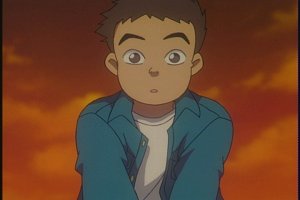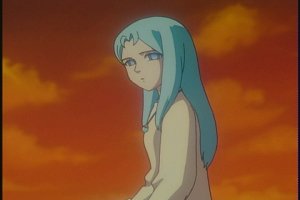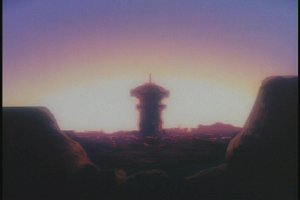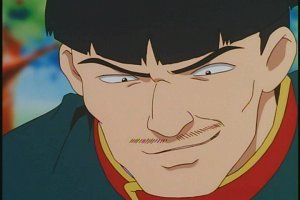 |
|
Far East Alchemy by Jenny Rae Rappaport |
January 2007
Now and Then, Here and There
"Ima Soko ni Iru Boku" ("Now and Then, Here and There") is simultaneously one
of the most depressing anime series that I know of, and also one of my all-time
favorites. It is a violent anime; most anime is violent in one sense or another, but "Now
and Then, Here and There" is particularly violent in the sense that oftentimes the
violence depicted is violence towards children. It is not an anime series for the faint of
heart, and at times, it is hard to watch the episodes, one after the other. But if you are
able to steel yourself against the violence, then you're in for one hell of an anime-watching experience.
The enigmatic title refers to the fact that the show takes place in two radically
different time periods. It begins in present-day Japan, where we are introduced to
Shuzo Matsutani or "Shu", as he prefers to be called, who is the hero of the series.
 Shu is perhaps twelve years old, and seemingly nothing more than a
brash and impulsive kid. After his loss at a kendo match, he is walking home, when he
notices a girl sitting on top of an industrial smokestack, watching the sunset. Being that
the smokestacks are an old childhood play area of Shu's, he is driven to investigate the
girl, and proceeds to climb up an adjacent smokestack. Never mind that the
smokestacks are very tall, falling apart, and are in the middle of a clearly-marked
construction zone; this is Shu we're talking about.
Shu is perhaps twelve years old, and seemingly nothing more than a
brash and impulsive kid. After his loss at a kendo match, he is walking home, when he
notices a girl sitting on top of an industrial smokestack, watching the sunset. Being that
the smokestacks are an old childhood play area of Shu's, he is driven to investigate the
girl, and proceeds to climb up an adjacent smokestack. Never mind that the
smokestacks are very tall, falling apart, and are in the middle of a clearly-marked
construction zone; this is Shu we're talking about.
When the girl at the top of the smokestack finally turns her head to speak to Shu,
you can immediately tell that she's not a part of his world. Her eyes are blue within
blue, and her name is Lala Ru.  She speaks softly and with what
seems like great deliberation, and to both the viewer and Shu she is fascinating. There
is only a brief interlude though, before a gaping portal opens in the sky and soldiers and
war machines appear, all hunting for Lala Ru.
She speaks softly and with what
seems like great deliberation, and to both the viewer and Shu she is fascinating. There
is only a brief interlude though, before a gaping portal opens in the sky and soldiers and
war machines appear, all hunting for Lala Ru.
Commanded by Abelia, a woman of harsh beauty and cruel intelligence, the
soldiers proceed to quickly capture Lala Ru. In a whisper that is almost the equivalent
of shouting for her, Lala Ru pleads with Shu for help. Never one to resist a challenge,
Shu immediately begins to attack the soldiers and their war machines; when Abelia
realizes that Lala Ru is in danger of being taken from her, she opens the portal and
steps through, taking the soldiers, the war machines, and Shu with her.
What a plot, right? Well, I'll admit it: I've just told you the basics of the first
episode in the series, but as there's thirteen episodes overall, I don't see that as much
of a hardship. You have to understand how Shu gets into the "then" portion of the title;
it's not enough to simply say that he is somehow transported away from present-day
Japan; you have to understand why he gets swept away from his life and brought
forward into the future.
Because perhaps it is the future that Shu is transported into, but where and
when in the future are questions which are currently left unanswered. Is it the future of
Earth that Shu finds through the portal? Is it an alternate Earth? An alternate reality?
The only thing we know is that it's as far away from Japan as you can possibly get.
Where the portal leads is a bleak desert land and the even bleaker battleship
that sits marooned within it. Hellywood is its name,  and it's an
interesting creation, all pieces of metal that are seemingly bolted together at random.
It's filled with legions of soldiers, many of them children, all under the command of
Abelia. The supreme ruler of Hellywood, however, is King Hamdo-a more insane man
than any despot you'll find in our world. He is obsessed with Lala Ru,
both on a creepily sexual level, and also because she has the special power to
manipulate water with the pendant she wears around her neck.
and it's an
interesting creation, all pieces of metal that are seemingly bolted together at random.
It's filled with legions of soldiers, many of them children, all under the command of
Abelia. The supreme ruler of Hellywood, however, is King Hamdo-a more insane man
than any despot you'll find in our world. He is obsessed with Lala Ru,
both on a creepily sexual level, and also because she has the special power to
manipulate water with the pendant she wears around her neck.  Obviously, in a desert
world, this is a valuable talent, and she's the only one who can do it. Not to mention
that Hellywood works on some sort of fuel that needs to be dissolved into water to
activate it, and they just don't have the water available to actually use that fuel to move
the ship-hence the being marooned in the middle of the desert.
Obviously, in a desert
world, this is a valuable talent, and she's the only one who can do it. Not to mention
that Hellywood works on some sort of fuel that needs to be dissolved into water to
activate it, and they just don't have the water available to actually use that fuel to move
the ship-hence the being marooned in the middle of the desert.
This is a problem for Hamdo, since besides being mad as a hatter, he also has
incredibly strong megalomaniac tendencies. He wants to conquer the world, and will
stop at nothing to do so. Using Abelia as his tool, he sends his army of child soldiers
out on missions in the surrounding desert, using them to capture, kill, and enslave the
villagers in the villages that they find. This perpetuates a cycle that started when the
children themselves were first captured and forcibly enlisted in Hamdo's army.
The characters of the child soldiers are among some of the most disturbing ones
presented in the entire series. Sure, Hamdo's insane, but that's not really that
frightening in the grand scheme of things. What's damn scary is watching how the
children are warped and used for his purposes.
At one point in the series, Shu is forcibly enlisted into Hamdo's army. Nabuca
and Boo, respectively, Shu's squad leader and fellow soldier, are the two child soldiers
whose portraits are painted the brightest. Boo is perhaps six or seven years old, and
Nabuca can only be a year or so older than Shu, at most. Yet both of them have a
scary determination and utter devotion to Hamdo and his army; it's the only life they
know, and they've been lured into it by the false promise that they can return to their
villages after Hamdo's war is over. They accept the squalid living conditions, the torture
inflicted on Shu and others in the name of the military's hierarchy, and the constant war
that they are engaged in. They are capable of committing horrible acts against those
they attack, and yet they are still vulnerable children inside. They are surviving as best
as they know how, and it's a truly chilling way of existence.
When Shu is thrust into their midst, his combination of optimism and bravado is
refreshing. He is far from his home, has been treated atrociously due to his helping
Lala Ru, and yet he still believes that the world of Hellywood can be a good place. He
sees the goodness that he believes exists at the core of each person, and it is that
strong tenet that keeps him going through his travails. He is determined to help rescue
Lala Ru from Hamdo's clutches; he has promised her, back in modern-day Japan, that
he will help her, and he'll be damned if he doesn't. There's not a doubt in any viewer's
mind that Shu would love to get back to his home, but while he's stuck in the "there" of
the series title, he's going to do the best that he can to help. It may seem like he has a
savior complex, but I feel that he's the brightest light in the entire world of Hellywood,
lending hope to all those that meet him. And that's a good thing.
Because we're back to one of the real mysteries of the show, which is where and
when the world of Hellywood is set? Before each episode begins, a quote is shown on
the screen, saying something to the effect that ten billion years is such an ephemeral
time. Does this mean that Hellywood exists ten billion years in the future, and that Shu
has been transported that distance in time through Abelia's portal? Is the fate of the
Earth to end up like Hellywood, a barren desert land? How can we tell that it's even the
same planet as the one we know today? And then, there's the more practical aspects
of this conjecture, including the fact that humans are bound to evolve somewhat during
the course of 10 billion years, yet they seem just the same as you and I. Yes, there's
random monster-like creatures that appear later in the series, but that at least is
plausible, given that they may have evolved from creatures that exist nowadays.
Finally, there is Lala Ru herself. She's clearly not the same as normal humans,
especially as at one point, she says that she's already lived for many, many lifetimes.
But do many, many lifetimes equal a total of ten billion years? And of course there's
her ability to manipulate water, which seems to be a talent unique to her in the entire
annals of human history. I'm personally undecided about where Hellywood actually is,
as I feel like there's a number of inconsistencies for it to definitely be ten billion years in
Earth's future. But yet again, it's obviously some world in the future or a world in an
alternate universe than ours, since they have much more advanced technology than we
do (i.e., witness the mysterious portal again). I'm not totally sure that I buy the fact that
Lala Ru has been around for ten billion years, either, although I admit that it lends a
certain air of romanticism to the entire series.
What I am sure about, however, is that "Now and Then, Here and There" is a
series that is utterly worth watching. I've barely touched upon the happenings of the
plot, and the series conclusion is one of the most satisfying that I've ever found in any
sort of film or TV series, animated or otherwise. It's hauntingly beautiful, and almost
justifies the violence that occurred before it could take place. Every time that I watch it,
I am left with the feeling that I have been touched by an artistic vision that is beyond my
comprehension, and yet I feel honored to have been allowed to share in it, through the
magic of my DVD player. Good art like this is damned hard to find.